




Your support is critical to our success.

Origin and Habitat: Monsonia multifidaSN|32358]]SN|32358]] is endemic to a small area on either side of the mouth of the Orange river in Namibia and Richtersveld Northern Cape,Republic of South Africa. This species has an extremely limited range. It occurs in several patches of about 20-30 m².
Habitat snd ecology: This tough plant occurs within the Lower Orange River Zone in an area roughly between 10-60 km from the sea together with Tylecodon buchholzianusSN|12173]]SN|12173]] and Conophytum loeschianumSN|22696]]SN|22696]]. This tough plant grows in dry, exposed stony flats on almost pure rock (usually shale) and among dunes. This species is threatened by severe, ongoing habitat loss and degradation across its range in South Africa severe overstocking of livestock is causing trampling disturbance that is negatively impacting all plant species in the area, even those that are not grazed. Mining expansion is causing not only ongoing habitat loss, but also degradation for a wide area surrounding the mines, mainly due to dust blowing from exposed mine dumps, burying dwarf species such as this one, and irresponsible off-road driving of vehicles across sensitive quartz habitats. In Namibia this species also occurs largely within a diamond mining area. It is a long-lived, slow growing species that seldom recruits, and the population reduction would be within one to two generations.
Synonyms:
- Monsonia multifida E.Mey.
- Sarcocaulon multifidum E.Mey. ex R.Knuth
ENGLISH: Cistus-flowered Bushman's Candle, Red-throat Dwarf Candle Bush, Candle bush, Bushman candle
AFRIKAANS (Afrikaans): Dwergboesmankersie, Boesmankers
Description: Monsonia multifidaSN|32358]]SN|32358]], best known as Sarcocaulon multifidum, was first described by Knuth in 1912. It is a semi-erect dwarf shrublets with long-lived, fleshy and knobbly stems, being able to reach to 20 cm high, and up to 25cm wide with swollen main root. It usually lacks spines and has greyish, finely divided, hairy leaves. The delicate blooms of Sarcocaulon multifidum are white, pale pink or magenta with red or crimson throat markings and sometimes, but rarely, pure white.
Derivation of specific name: The specific name comes from Latin 'multifidus, a, um' many-cleft, many-parted, in reference to the multifid or segmented foliage.
Stems: The main stem is a knobbly, succulent, caudex stem branching 20-40 mm above ground; branches short, thick, spreading horizontally, rarely more than 2 cm across, without spines or occasionally with blunt spines to 6 mm long, bark greyish-brown to greyish-white.
Root: Swollen.
Leaves: Deciduous, long petioled, usually erect, in two rows along the top of each horizontal branch (in erect branches, leaves are in the normal ranks of four). Petiole (6-) 14 (-24) Long. Lamina 2- to 3- pinnatisect, deeply cleft, hairy, very broadly ovate to oblate (8-) 16 (-24) mm long, (12-) 22 (-34) mm broad The base of the petiole is slowly transformed into spines. Stipules minute, scale-like, persistent, hidden in leaf bases.
Flowers: Hermaphrodite, hypogynous, solitary to 3.5 cm in diameter. Peduncle very short. Pedicel pilose, 12-32 mm long. Sepals 5, 9-12 mm long, 3-5 mm broad densely hairy. Petals 5 white, pink or magenta, often with dark red or crimson markings towards the base. Stamens with long filaments 7-9 mm long, short filaments 5-6 mm long; basal 2 mm of filaments fused; anthers 3 mm long. Ovary and style sericeous; stigmas 2-3 mm long.
Fruits (mericarps): 70-80 mm long; base 7-8 mm long, tail 65-70 mm long.
Seeds: 3 mm long.
Bibliography: Major references and further lectures
1) Albers F. “Monsonia” in: Urs Eggli “Illustrated Handbook of Succulent Plants: Dicotyledons” Springer Science & Business Media, 2002
2) Urs Eggli, Leonard E. Newton “Etymological Dictionary of Succulent Plant Names” Springer Science & Business Media, 29 June 2013
3) Moffett R. O. : “The genus Sarcocaulon” in: Bothalia Vol. 12, N°. 4 (1979) : 581-612.
4) Umberto Quattrocchi “CRC World Dictionary of Plant Names: Common Names, Scientific Names, Eponyms. Synonyms, and Etymology” CRC Press, 22 November 1999
5) Williamson G. “Richtersveld” 168-169 (2000).
6) “Geraniums Around the World”, International Geranium Society., 1986
7) Jean-André Audissou “The genus Sarcocaulon (De Candolle) Sweet (1826)” in: CACTUS-AVENTURES International N° 70 Pages 8-14 <https://www.cactuspro.com/articles/_media/sarcocaulon:genus_sarcocaulon.p> web16 january 2016January
8) R. O. Moffett “The genus Sarcocaulon” Bothalia; Vol 12, No 4 (1979), 581-613. <http://www.abcjournal.org/index.php/ABC/article/viewFile/1424/1382> web 16 January 2016
9) John Manning “Field Guide to Wild Flowers of South Africa, Lesotho and Swaziland” Struik Nature, 2009
10) Albers, F. 1996. “The taxonomic status of Sarcocaulon (Geraniaceae).” South African Journal of Botany 62(6):345-347.
11) Snijman, D.A. 2013. “Plants of the Greater Cape Floristic Region 2: The extra Cape flora”. Strelitzia 30. South African National Biodiversity Institute, Pretoria.
12) von Staden, L. & Van Wyk, P.C.V. 2015. “Monsonia multifida E.Mey.” National Assessment: Red List of South African Plants version 2015.1. Accessed on 2016/01/16
13) Raimondo, D., von Staden, L., Foden, W., Victor, J.E., Helme, N.A., Turner, R.C., Kamundi, D.A. and Manyama, P.A. 2009. "Red List of South African Plants". Strelitzia 25. South African National Biodiversity Institute, Pretoria.
14) Patterson “A narrative of four journeys.” edn 2 113. t. 2 1790
15) Hermann Jacobsen “A handbook of succulent plants: descriptions, synonyms, and cultural details for succulents other than Cactaceae” Volume 1 Blandford Press, 1960
16) James Cullen, Sabina G. Knees, H. Suzanne Cubey “The European Garden Flora Flowering Plants: A Manual for the Identification of Plants Cultivated in Europe, Both Out-of-Doors and Under Glass” Cambridge University Press, 11/Aug/2011
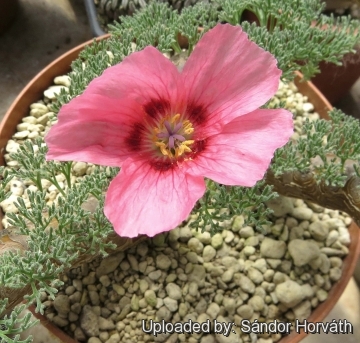
Monsonia multifida Photo by: Sándor Horváth
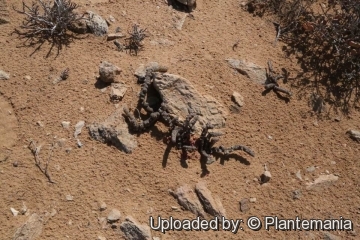
Sarcocaulon multifidum in habitat. Photo by: © Plantemania
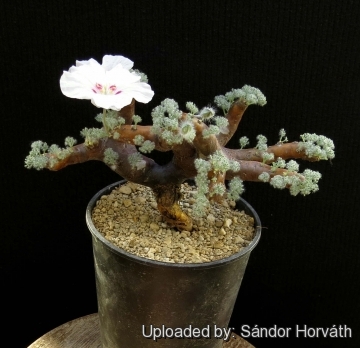
Monsonia multifida Photo by: Sándor Horváth
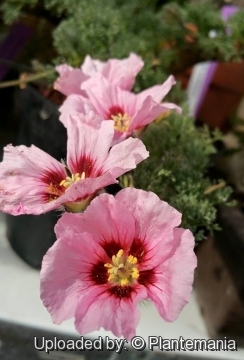
Monsonia multifida Photo by: © Plantemania
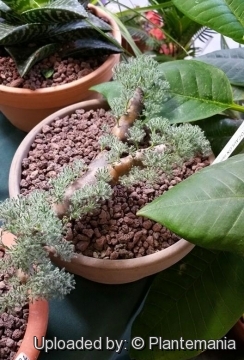
Monsonia multifida Photo by: © Plantemania
The gallery now contains thousands of pictures, however it is possible to do even more. We are, of course, seeking photos of species not yet shown in the gallery but not only that, we are also looking for better pictures than those already present. Read More...
Cultivation and Propagation: Monsonia multifidaSN|32358]]SN|32358]] is a decorative plant which has the fame to be difficult to care properly in cultivation, however it is relatively easily grown species, very suitable for bonsai. Seed-grown plants thrive and flower prolifically in cultivation while imported specimens rarely produce an extensive new root system and flower sporadically, but survive for many years.
Soil: The substrate must be very well draining and rather mineral in composition with at least 75% of pumice and lava grit.
Exposure: They require direct sunlight when in full growth, while a filtered exposition is best during the hottest period of summer, when the plants enter in their dormancy phase. They always grow best in positions where they receive long periods of strong sunlight.
Watering: They need to be regularly watered every 6 to 10 days whilst they are in active growth and and producing leaves, occasionally during dormancy. In cultivation it appear best not to let plants go into dormancy and to water year round. Nevertheless even in habitat the Sarcocaulons appear to be opportunistic and respond to precipitation events when they occur. As soon as the foliage starts to show signs of yellowing or withering, water should be withheld. It is very important that there is plenty of free air circulation around cultivated plants and also that they are not overwatered.
Temperature requirements: It is advised to maintain plants at a minimal temperature of 8°C during the winter.
Propagation: All sarcocaulon species are readily grown from seeds. Seeds should be sown just under the surface of the soil, in large seed trays or plastic pots. They should be planted out into individual containers when they are about two years old. The most dangerous period for seedling is in summer. They need to be kept dry whilst dormant but at the same time their trunk do not withstand continual drought. The seedlings adapt to the climate where they are grown and develop a vigorous root system. Propagation by cutting is rarely satisfactory and often cutting rarely branch out.
| Your Actions | |
|---|---|
| Back to Monsonia index | |
| Back to Geraniaceae index | |
 |
Back to Succulents Encyclopedia index |
Privacy stantement - Terms and conditions - How to cite - About us - Feedback - Donate



